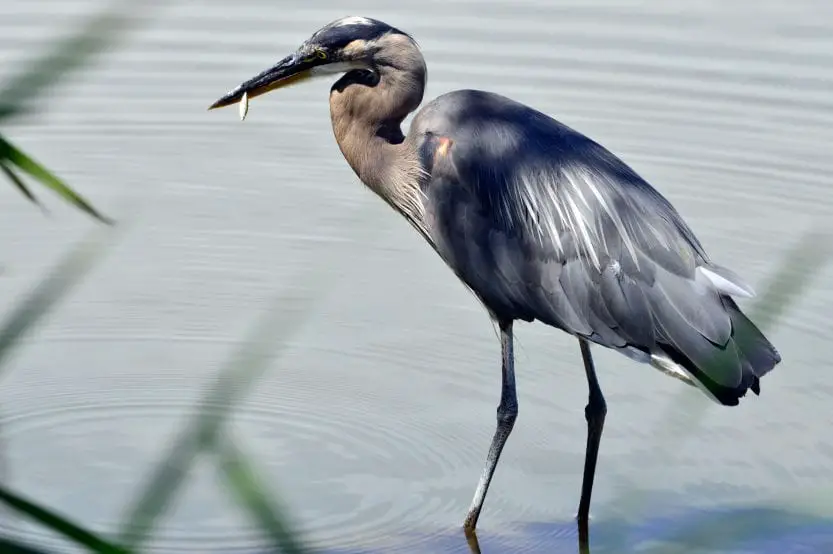The Blue Heron is a large bird with yellow and black eyes and a long beak. It is one of the most majestic birds that are found in North America. They have long legs and a gray underside, its wings and a part of its’ head near the eyes are a spectacular blue color. It has a curved neck, long enough for it to fish for its food while wading through rivers and streams. While this bird is in flight, its wingspan can extend up to six feet and looks enormous in the sky. It is the most commonly found bird in North America. The scientific name of the Blue Heron is Ardea herodias.
Read through this article to find out all you need to know about this beautiful bird that is blue.
Habitat of the Blue Heron.
Blue Herons are most suited to regions that have a neo arctic and a neo tropical climate. During summer and spring, they live and breed throughout Central and North America. This includes the Caribbean and the Galapagos Islands. IUCN Red List Status lists the Blue Heron as “least concern” because its population is currently increasing and thriving. There is no threat of endangerment or extinction of the Blue Heron species. They are found in many habitats. They live near mangroves, salt marsh swamps, and freshwater swamps. Blue Herons also like regions like flooded fields, lagoons, banks of rivers, and lake edges.
The Canadian population of the Blue Heron is only present there during the breeding season. When the lakes and rivers begin to freeze in late autumn, these birds migrate in flocks towards the south. The Blue Herons that live on the Pacific and Atlantic coasts stay throughout the year.
Diet of the Blue Heron.

This bird that is blue isn’t that picky when it comes to food. They eat fish, amphibians, and reptiles. They also eat insects and other small birds and mammals who live on the ground. As long as their game is within striking distance, they use their sharp beak to pierce large creatures and ingest them. If their food is smaller, then they grab them with their beak without having to pierce them.
The Blue Heron is an expert fisher bird. They slowly wade through the water looking for fish. They stand still for long hours, scouting the surface of the water and waiting for their prey to come within close range. Once they spot a creature that they can eat in the water, they strike with their sharp dagger-like beaks and catch their prey. They don’t chew their food, rather they swallow it whole. Sometimes, they try to swallow prey that is too big for them, and they choke to death. Even though these blue birds are expert fishers, they also eat a lot of mice, insects, and other creatures that scuttle around the ground.
The behavior of Blue Herons.

Blue Herons are up to 4 and a half feet in size with a wingspan of up to 6 and a half feet. When they are in flight, it is a joy to see this beautiful bluebird against the sky. Because of their large wingspan, they can cruise through the air at around 30 miles (ca. 48 km) an hour. They fold their neck into an “S” shape when they are in flight. While landing or when courting, they dangle their legs down from their body.
Blue Heron usually forage and hunt alone, but they nest in colonies. When they are away from their colony, they defend their territory by approaching intruders and arching their heads back. They point their bill towards the sky and stretch their wings wide in a defensive pose.
They are active during dusk and in the mornings when they can sight their prey easily. At night, they sleep amongst huge flocks of more than 100 other blue herons. They like to nest in tall trees, but some of them even nest in low shrubs on the ground. A female bird can lay two to seven eggs at a time. Both male and female parents incubate and protect the egg. They can be quite aggressive while protecting their nest and their young ones. Newly hatched chicks cannot survive on their own. They start to climb branches when they are 7 weeks old. When they reach two months of age, the chicks can fly, but they return to their nest and are fed by the adults for a few more weeks. The adult blue birds live up to 15 years of age.
The Blue Heron is a relatively quiet bird. They make a soft “kraak” if they are disturbed while in flight. They make a “frunk” when they are disturbed while nesting. When they see other birds that belong to their species, they make an “ar” sound to greet them. All-in-all Blue Herons can make up to 7 different sounds.
Mating Habits.
During the breeding season, Blue Herons have a single mate. The pair bond lasts only for that nesting season, and the herons take up new mates the following year. This is called serial monogamy.
To attract mates, male herons perform displays of courtship including when they are in flight. They posture to females with their feathers fluffed up.
Blue Herons in the north mate from March until May and from November to April in the south. Females lay from 3 to 7 eggs at a time and the chicks become sexually mature when they are 22 months old.
Nest Description.

Blue Herons mainly nest on trees, but they also use the ground, bushes, and other stable structures for their nest. The males arrive at a nesting colony first. A colony can consist of more than 500 individual nests. After the males arrive at a colony, they begin courting the female blue herons to mate with them.
Male Blue Herons do most of the work collecting the material for their nests. They collect sticks from the ground, nearby shrubs, and other abandoned nests and give it to the female blue heron. She takes the material and weaves a saucer-shaped nest. The nest is lined with pine needles, little twigs, and dry grass. It is covered with leaves and some moss. The building of this nest is finished in 3 days, or can also take up to 3 weeks. The time taken to build the nest depends on the structure of the nest. There are simple nests that are 20 inches (ca. 51 cm) across, and there are very elaborate nests. These elaborate nests are 4 feet (1.22 m) in length and 3 and a half feet deep. These big nests are used by the birds for years.
Newly laid eggs have a pale blue color that fades with passing time. The newly hatched chicks have open eyes that are bluish gray. They are covered in pale gray feathers, and they can vocalize.
Conservation of Blue Herons.
The number of Blue Herons has increased from 1996 to 2014, based on data collected by the North American Breeding Bird Survey. In southern Florida, because of the increase in mercury levels in local waterways, the Great White Heron group of herons have decreased in number.
There is an estimated continental population of 83,000 breeding birds according to the North American Waterbird Conservation Plan. The Great White form of Blue Heron is at risk of being threatened if conservation action is not taken. This form of Blue Heron appears on the 2014 State of the Birds Watch List. The Blue Herons themselves rank at 8 out of 20 on the Continental Concern Score.
Blue Herons are found in North America throughout the year, only during the breeding season in Canada, and only during winter in Mexico. Since Blue Herons are dependent on wetlands for their food and survival, they face the threat of habitat loss by the incursion of motorboat traffic, water logging, and other human intrusions. The other threats that blue herons face are reduced water quality and chemical pollutants in the water. Pollutants like DDT and PCB’s and newer industrial wastes continue to lower the population of nesting blue herons.
Other Interesting facts about Blue Heron.
- During the breeding season, the blue color of a heron will become bright blue, their eyes turn reddish and their bill becomes an orange hue.
- On a hot day, blue herons drop their wings and open their beak. “Gulag fluttering” is a practice where they flutter the muscles of their throat to increase evaporation and cool themselves down.
- Blue Herons can swallow fish that is wider than their neck. If their prey is too large, sometimes they choke to death.
- They spend ninety percent of their time waiting and stalking for food.
- Blue Herons can sit on floating large leaves as they wait for fish to swim by.
- Blue Herons have existed for around 25 million years, from the Cenozoic age. Fossil records of Blue Heron in North America date from 1.8 million years ago.
Newly hatched chicks have gray eyes, and they turn yellow as they grow older.



